What is CMR (customer-managed relationship)?
Customer-managed relationships (CMR) are relationships where a business encourages the customer to manage their access to information, ordering, and other aspects of their relationship.
CMR is a viable alternative or a way to incorporate it into CRM or Customer Relationship Management.
CMR Full Form
CMR Full Form is a Customer-managed relationship.
CMR full form in medical?
Cardiovascular Magnetic Resonance (CMR), is a collection of magnetic resonance imaging techniques (MRI) designed to assess cardiovascular morphology and function, myocardial blood flow, tissue characterization as well as coronary artery diseases.
CMR full form in banking
Client Master Report (CMR) is a digitally signed PDF certificate that a broker issues to a customer with details about their demat account. This includes the demat ID number, date of birth and bank details. CMR copies are used to transfer stocks1 from a demat to another broker.
What are the three functions of a customer-managed relationship?
CMR is composed of three functions:
- The customer should be able to own all of their information including their profile, transaction history, and any other information that can be inferred, such as their marital history or behavior.
- All departments should provide this information to customers.
- It is important to design the system with customer needs and feelings in mind.
CMR aims to maximize customer satisfaction and improve the customer experience. CMR lets customers define their communication style with the company and what products or services they want to purchase.
CMR is a way for enterprises to keep up with the times and respond to customer demands for greater control.
CMR vs CRM
CMR and CRM are often confused.
CRM is a system that aims to improve the relationship between the customer and the company by collecting data. Companies use CRM tools for many different purposes. It can be in the form of marketing automation, or contact management.
CRM tools can be used to monitor interactions with customers on social media, such as Facebook, or LinkedIn. They can also collect information from sales teams, or create marketing campaigns. The CRM software can be used to collect customer data, streamline processes, and make it easier to connect with customers.
CMR, on the other hand, is management which focuses more on giving the customer control in the marketing process.
CMR systems are designed to be customer-centric. CMR gives customers more control and improves customer retention. CMR is a way to empower customers and achieve CRM benefits.
The pillars of customer-managed relationship
The following are some key ideas that will guide CMR’s business strategy.
- Effective follow-up and communication CMR is about keeping in touch with customers, both existing and prospective in the best way for them. It could involve talking to customers, redefining your sales process or investing into marketing automation.
- Building customer loyalty CMR is about understanding what customers want and need from an organization. To do this, companies must examine the customer journey to determine what value customers may be looking for from their buying experience.
- Flexibility CMR says that businesses shouldn’t just focus on profitability, but should also provide the best service to their customers. This might result in a short-term loss of revenue for the business, but the increased number of customers and engagement with the customer will pay off in the end.
- CMR’s goal is to make customers happy. To maximize customer satisfaction, market research will be required as well as training for customer support staff. Some customers may prefer to be contacted in real-time, while others might prefer to receive updates via email marketing. Sales reps can ask about these preferences.
- Forecasting. This is the use of management tools to predict customer behavior throughout their entire lifecycle.
For More Information visit Our Homepage:



